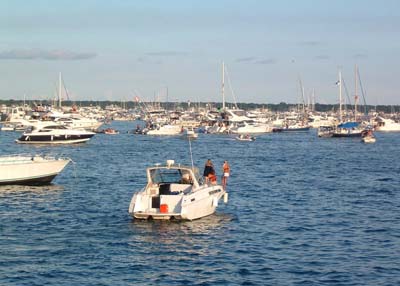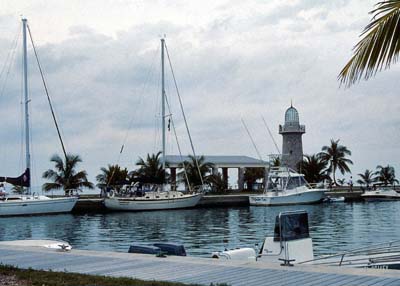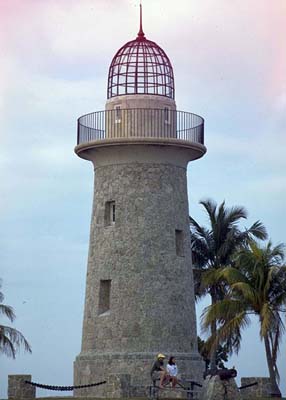
Park staff works to increase awareness
HOMESTEAD, Fla.— If someone compiled a list of the most beautiful places to visit in South Florida, Biscayne National Park would be near the top of that list. If not the very top.
Each year, approximately one half million people make their way down to Homestead, Fla. to see the watery wonders that surround Biscayne National Park. However, according to Park Superintendent Mark Lewis, those numbers should be considerably higher.
“A large percentage of people in South Florida are unaware that a national park is so close to them,” said Lewis. “We want to connect better with more people than we do now. That’s the greatest desire we have. If we can do that, I believe more people will start visiting.”
 |
Most people who visit Biscayne National Park do so in their boats. (Photo courtesy of National Park Service). |
The average number of visitors Biscayne National Park receives every year do not compare favorably to those in other national parks around the country.
For instance, last year the Grand Canyon in Arizona welcomed more than four million visitors. The Everglades National Park, which is relatively close to Biscayne National Park, welcomed more than one million visitors.
So why are there not more people visiting Biscayne National Park? According to historian and activist Greg Bush, accessibility is one issue.
“There’s no place to get to Biscayne National Park until you get near the south end of Miami-Dade County in Homestead. And that area is unknown to so many people,” said Bush, a professor on public space at the University of Miami. “Most people visit the park with a boat, but not many people have boats.”
Park Ranger Gary Bremen echoes that statement.
“Most of our visitors are people coming in on boats. But we realize many folks in South Florida don’t have boats, so that really limits how many visitors you get,” said Bremen. “Since there aren’t signs at every angle and edge in the area, many people don’t know there’s a park close to them. Even when folks are inside the park, they rarely realize they’re inside Biscayne National Park.”
Lewis said the park management staff has taken preliminary steps to counter this issue of accessibility.
“For the last year or so, we’ve been in negotiations with the City of Miami and Miami-Dade County to see if we can have a new facility for the park somewhere in the downtown Miami area. We’ve approached them because they’re working on a Virginia Key master development plan,” said Lewis.
“So we’re using that as an opportunity to see if we can get more of a presence and reach more people. That would be big.”
| Visitors to Biscayne National Park can dock their boats at Boca Chita island harbor (Photo courtesy of National Park Service). |  |
Bush believes an access point north of the park would be a good idea. As it stands, the park’s northern-most boundary stops at the southern tip of Key Biscayne. However, he thinks the management at Biscayne National Park ought to consider another pressing issue: promoting the park as an appealing place.
“For them to have a northern terminus with some boats making regular trips down to the park would be very useful in getting more tourists. It would get people to be aware of the natural environment they inhabit,” said Bush. “Biscayne National Park is a very nice place. Anyone who visits will see that. The question is: can they draw more people to it? Can they make it a more exciting place?”
While Bremen believes it would be ideal for more people to know about and visit Biscayne National Park, he does not think it is a priority to actively promote the park.
“The purpose of a national park is not to provide a tourist outlet,” said Bremen. “It’s really about protecting specific resources in the area.”
So what has Biscayne National Park done to make its presence better known in South Florida? Well, several things.
For one, the public relations staff has tried to reach out to people in the community who do not speak English.
“We recently started publishing all of our brochures and maps in Spanish and Creole to try to reach a portion of the community that may not speak English. We have also renovated our exhibits so they feature other languages commonly spoken in South Florida,” said Lewis. “And whenever we hold public meetings, we make sure we have translators and interpreters available. We really want to be better communicators.”
Just as importantly, the park has reached out to local schools in hopes of instilling an appreciation for the nature of South Florida.
“We spend thousands of hours and dollars with our staff for a range of schools here in the community, trying to talk to students about the natural resources that surround them and why it is important to preserve them,” said Lewis. “Whether or not they make the translation that they can go out a few miles from their house and see a national park with their families, I don’t know.”
Biscayne National Park has also reached out to the press to increase its standing in the community.
“We’ve had the local and regional print and broadcast media feature stories about the park,” said Susan Gonshor, chief of Interpretation and Public Information. “We’ve also worked with a local cable production called Waterways, who produces 30 minute documentary-type programs that air on local WLRN Channel 37. Many of these episodes feature the park.”
But feature pieces and documentaries about the park are just a prelude to the kind of exposure Biscayne National Park would like to see about itself in the future.
“Long term, one of our ideas is to work with local theaters to air short movies on Biscayne National Park and the national parks in South Florida,” said Gonshor. “We’ve also made initial contacts with the Welcome Channel, which is aired in the hotels and motels in Miami area, to discuss the possibility of having them air our movies to orient visitors with the park.”
 |
The lighthouse at Boca Chita Key, the park’s most popular island, gives visitors a spectacular view of the surrounding area (Photo courtesy of National Park Service). |
Apart from these efforts, Biscayne National Park has also worked with public and private entities to promote and study the area.
“They’ve been involved with some businessmen and farmers in South Dade to promote agro-tourism in the area, so people will come down to look at the nature of agriculture. That’s a very interesting initiative,” said Bush. “They’ve also worked with scientific and archaeological societies to look for things underwater that they might feature in future exhibits.”
So how successful have these steps been? Lewis believes the park’s efforts have definitely been noticed by the community. But that should not be a reason for Biscayne National Park to stop there.
“We get a lot of positive feedback on our website. And when we give out questionnaires, we usually get high remarks,” said Lewis. “Still, it’s one of those things where we can always do better. We can always do more.”
If You Go
9700 SW 328th St., Homestead, Fla. 33033
305-230-7275
http://www.nps.gov/bisc/index.htm
Biscayne National Park’s headquarters are open daily from 7 a.m. to 5 p.m.
The Dante Fascell Visitor Center is open daily from 9 a.m. to 5:30 p.m.
The water portion of the park is open 24 hours a day.
Biscayne National Park has no entrance fees.
However, there are fees for certain things:
- $15/night camping fee for up to six people and two tents.
Reservations not accepted for individual tent sites - $30/night camping fee for groups of more than six people and two tents at Elliott Key
Reservations required - $20/night fee for boats docked overnight in Elliott Key or Boca Chita Key harbors
First come-first serve basis
Reservations not accepted - $100 rental fee for Boca Chita Key Pavilion
Half-day rental (four-hour period)
A $100 refundable deposit required to reserve space
Visitors can park their vehicles in the parking section connected to the mainland.
Vehicles parked overnight require a permit that can be obtained at the Visitor Center.
Pets are welcome at Convoy Point and Elliott Key as long as they are on a leash.
Snacks, such as sandwiches, chips, cookies, and soft drinks are sold at the concession stands at the Dante Fascell Visitor Center. However, there are no restaurants, food services, or water fountains in the park.

Comments are Closed